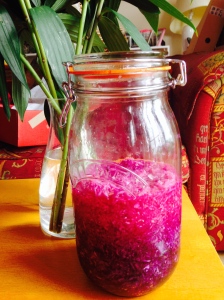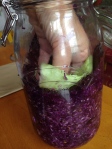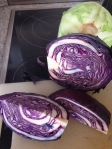 Sauerkraut is a traditional fermented food which produces probiotics, cheaply and naturally.
Sauerkraut is a traditional fermented food which produces probiotics, cheaply and naturally.
Probiotics are good bacteria which help good digestion, as Sacramento Natural Food Co-op explains.
“Fermented” food can sound a turn-off to our modern ears. But, for aeons, every traditional society has used lacto-fermented food – kimchi from Korea and cortido from Latin America, says Nourishing Days – for healthiness.
Sauerkraut hails (as do my ancestors) from Eastern Europe, Germany/Poland etc
I have been thinking about making sauerkraut for ages.
I bought a Kilner jar in preparation. I procrastinated. I had never made it before so feared failure. Making any food is a leap of faith. Will its mysterious alchemy work?
Then, by chance, I got a comment from Annie Levy, who holds UK-based lacto-fermentation workshops. Can you imagine? The maven of probiotics turns up on this ‘ere blog. Of course, I have to make sauerkraut. Now.
So I read Annie Levy’s great piece on making sauerkraut.
I also consulted this sauerkraut one from the Kitchn and a few others. Exciting to be in the zeitgist – there is no shortage of posts on lacto-fermentation.
Lacto, I query? It means the type of bacteria which creates lactic acid. Lactic acid protects fermented food from being invaded by bad bacteria, says Natural News.
Basically, to make sauerkraut, you add salt to cut-up raw vegetables. Salt naturally draws out the water from the veg. Then the veg soaks in its own salty water for days (and then keeps in a fridge for weeks). The soaking-in-the veg’s-own-water creates the fermentation process which in turn produces sauerkraut with loads of friendly bacteria.
Sauerkraut
1 raw cabbage (and/or raw carrots/garlic etc)
1 tablespoon salt
Spices of choice: I used 1 dried chilli, fenugreek, cumin seeds and black peppercorns
Method: Slice cabbage thinly (my food processor did the job otherwise use a sharp knife). Mix the salt and veg in a bowl, rubbing the salt in with your fingers. Leave the salted veg in a covered bowl. I am amazed how quickly I was squeezing water out of salted cabbage. Mix again. Keep cabbage submerged in its water with a heavy plate.
 Here is me submerging the veg in the Kilner jar using a cabbage leave to press it down. I got anxious about this bit. However, it is OK to add a few dessertspoons of water to make the sure the veg is covered. After 12-24 hours, transfer the salty cabbage from covered bowl to a Kilner jar and keep in the fridge.
Here is me submerging the veg in the Kilner jar using a cabbage leave to press it down. I got anxious about this bit. However, it is OK to add a few dessertspoons of water to make the sure the veg is covered. After 12-24 hours, transfer the salty cabbage from covered bowl to a Kilner jar and keep in the fridge.
I used two organic cabbages (and two tablespoons of salt). I thought two cabbages would not fit in the Kilner jar …but they did not even fill it!
The quantity of salt to use is up to you, but 3 tablespoons per 5 pounds of vegetables is a good ratio to follow, says website, Paleo Leap.
The result: Having lived with my jar of sauerkraut for the month of July, with regular servings with a variety of dishes, I can report: it is delicious. A blend of salty and sweet, and easy to eat.
And, it works. For instance, last night, my digestion felt weak. I could not be bothered to eat. So, I had a small bowl of sauerkraut and within an hour, my appetite had returned, heartily. The magic of friendly bacteria!


